

Driverless Carts Are Coming Sooner Than Driverless Cars. I’m delighted to be spending this week committing overt acts in furtherance of the Volokh Conspiracy.
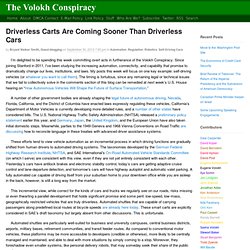
Since joining Stanford in 2011, I’ve been studying the increasing automation, connectivity, and capability that promise to dramatically change our lives, institutions, and laws. My posts this week will focus on one key example: self-driving vehicles (or whatever you want to call them). The timing is fortuitous, since any remaining legal or technical issues that we fail to collectively solve in the comments section of this blog can be remedied at next week’s U.S. House hearing on “How Autonomous Vehicles Will Shape the Future of Surface Transportation.” A number of other government bodies are already shaping the legal future of autonomous driving. These efforts tend to view vehicle automation as an incremental process in which driving functions are gradually shifted from human drivers to automated driving systems. CMU's Autonomous Car Doesn't Look like a Robot.
The future of automobile autonomy isn't going to involve cars covered in cameras and radar and lasers. It's going to be all invisible, and CMU is already there. The 2011 Cadillac SRX in the picture above is an autonomous car. Carnegie Mellon University had it drive itself 33 miles last week on public roads, from from Cranberry, Pa. to Pittsburgh International Airport. At first glance, you probably wouldn't be able to tell that the car is self-driving, because self-driving cars looked like this just five years ago: That's CMU's BOSS competing in the DARPA Urban Challenge in 2007, with who knows how many sensors mounted all over it. No One Understands The Scariest, Most Dangerous Part Of A Self-Driving Car: Us. The most dangerous moment in a self-driving car involves no immediate or obvious peril.

It is not when, say, the computer must avoid a vehicle swerving into its lane or navigate some other recognizable hazard of the road -- a patch of ice, or a clueless pedestrian stepping into traffic. It is when something much more routine takes place: The computer hands over control of the vehicle to a human being. In that instant, the human must quickly rouse herself from whatever else she might have been doing while the computer handled the car and focus her attention on the road. As scientists now studying this moment have come to realize, the hand-off is laden with risks. "People worry about the wrong thing when it comes to the safety of autonomous cars," says Clifford Nass, a Stanford University professor and director of the Revs Program, an interdisciplinary research center. Stanford University's driving simulator.
But is that just enough time, too much or too little? Japan No Longer Gung-Ho on Vehicle-to-Infra Alone. Self-driving Automobiles: Robotics over Romance. August 31, 2013 “I am committing to be ready to introduce a new ground-breaking technology, Autonomous Drive, by 2020, and we are on track to realize it.” — Carlos Ghosn, CEO Nissan Motors.

RobotCar the New Autonomous Car - Roboticmagazine. A new autonomous car called RobotCar is designed by the Mobile Robotics Group (MRG) of Department of Engineering Science at Oxford University in the UK.

What distinguishes this autonomous car from others is its price in comparison to its technology. Currently, the team has 22 researchers and is in collaboration with Nissan by using their technical support and hardware of the vehicle. RobotCar is a modification of Nissan LEAF. The primary interest of the research team is to create an infrastructure-free navigation through information engineering and autonomous perception. The project aims to ensure a safe drive by connecting with other drivers and utilizing the roads dexterously while leaving some free time for the drivers. RobotCar the New Autonomous Car - Roboticmagazine. Mercedes to launch car-to-car communications this year. Vehicle-to-vehicle communications are a fundamental pillar of autonomous, self-driving cars.
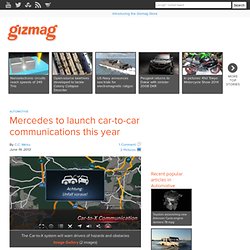
Once vehicles can exchange data with each other and the greater driving infrastructure, they'll be able to "see" and adapt to driving obstacles more completely, preventing accidents and delivering more efficient driving. The Impact of Automation on Environmental Impact Statements. Cross-posted from Volokh Conspiracy.
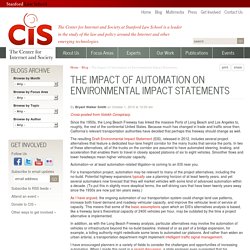
Since the 1950s, the Long Beach Freeway has linked the massive Ports of Long Beach and Los Angeles to, roughly, the rest of the continental United States. Because much has changed in trade and traffic since then, California’s relevant transportation authorities have decided that perhaps this freeway should change as well. The resulting Draft Environmental Impact Statement (EIS), released in 2012, includes several project alternatives that feature a dedicated four-lane freight corridor for the many trucks that service the ports. How self-driving cars could change the future of marketing. July 22, 2013 - 2:32 pm ET Other blogs Related Topics Self-driving cars may be a long way from becoming part of daily life, but people are already dreaming up futuristic ways for restaurants, retailers and other businesses to reach consumers -- potentially a dramatic transformation of the marketing and advertising landscape.
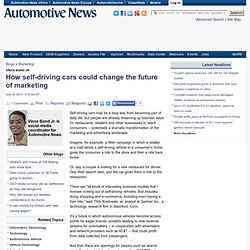
Continental AG, Google to work on self-driving cars - report. How Robots in Outer Space Are Influencing the Cars of the Future - Emily Badger. NASA engineers referred to the most crucial moments in the Mars Curiosity mission last summer as the "seven minutes of terror.
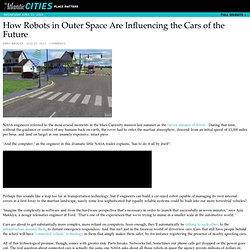
" During that time, without the guidance or control of any humans back on earth, the rover had to enter the martian atmosphere, descend from an initial speed of 13,000 miles per hour, and land on target in one insanely expensive, intact piece. "And the computer," as the engineer in this dramatic little NASA trailer explains, "has to do it all by itself": Perhaps this sounds like a leap too far in transportation technology, but if engineers can build a car-sized robot capable of managing its own internal errors in a first foray to the martian landscape, surely some less sophisticated but equally reliable systems could be built into our more terrestrial vehicles?
"Imagine the complexity in software and from the hardware perspective that’s necessary in order to launch that successfully in seven minutes," says Aziz Makkiya, a design telematics engineer at Ford. Honda Demonstrates Vehicle-To-Pedestrian Safety Technology. Honda demonstrated a new safety feature on Wednesday that harnesses the power of the smartphone to see pedestrians where a driver and existing camera sensors may not.
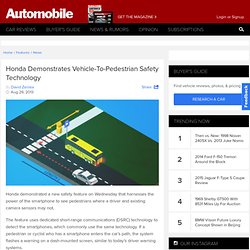
How Our Driverless Future Will Transform The Economy. We have become desensitized to technological progress—a new laptop is coming out and it is 20% faster, big whoop—but if there’s one technology that is still fascinating to us, it’s the self-driving car and its promise of a more convenient future.
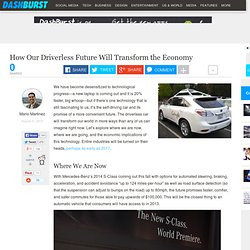
The driverless car will transform our world in more ways than any of us can imagine right now. Let’s explore where we are now, where we are going, and the economic implications of this technology. Entire industries will be turned on their heads, perhaps as early as 2017. Where We Are Now. Next Big Future: Progress to deployment of vehicle to vehicles communication and crash avoidance to help drivers avoid or reduce the severity of 80 percent of unimpaired vehicle crashes. On Thursday, the National Highway Traffic Safety Administration said it "could be at the verge" of a breakthrough to allow vehicles to communicate with each other and "transform the nation's surface transportation safety, mobility and environmental performance. " The NHTSA has just completed a yearlong test in Ann Arbor, Mich., with 3,000 cars, trucks, and buses connected by Wi-Fi to help avoid crashes and improve traffic flow.
OEM. What Google And Uber Have In Store For The Future. Last week, I published a piece of speculative fiction about how I saw Google and Uber evolving as companies and taking advantage of new technology 10 years from now. That “Dispatch From The Future” got quite a lot of attention, in part because more than a few people got very excited about the prospect of driverless cars and the impact that they can have on the way we think about transportation. Since a lot of people read it as the future is now, and others have said that my ideas about what the world will look like in 10 years might actually be conservative, I thought it might make sense to explain some of my thinking around my outlook for the driverless car.
EXCLUSIVE: Google Designing Its Own Self-Driving Car, Considers ‘Robo Taxi’ From left, Google Chairman Eric Schmidt, CEO Larry Page, and co-founder Sergey Brin in 2011. (Credit: Google) By Amir Efrati.